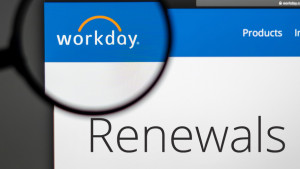- Erwann Couesbot
- Reading Time: 4 minutes

Though Workday has primarily been known as a leader and innovator in the HCM space, their recent acquisitions and expansions into the financials, planning, and analytics markets put them up against ERP heavyweights such as SAP and Oracle.
With competition like this, Workday will be adopting similar sales tactics that make it difficult for organizations to achieve a highly competitive deal. Whether you are negotiating your first deal, renewing a Workday subscription, or considering adding new solutions, here are a few key commercial terms you should address.
1. Pricing Transparency
Like most major ERP providers, Workday makes it difficult for organizations to obtain a sufficient level of price transparency in their price proposals.
Rather than allowing customers to clearly see the list price, discounts, and associated net fees on a line item basis in proposals and order forms, Workday has been known to bundle the various SKU’s and simply provide the annual net fees associated with that bundle. This makes it not only difficult to understand how competitive your deal is but also puts you at a disadvantage come renewal time or when you are considering licensing additional Workday products.
To gain better price transparency from Workday, you should request visibility into two key commercial terms associated with pricing:
a) Price List
In an ideal world, you could obtain a current and complete price list, but Workday keeps this close to the vest and will not readily provide an itemized price list. However, they have provided customers with some level of visibility into list prices, so it is worth pressing Workday to at least provide the list price for each product listed in their proposal.
Ambiguous price lists are common among vendors, but unlike many other ERP providers, Workday’s list prices can vary per product because they depend on:
- The number of Full Service Equivalent (FSE) workers (or students in the case of Workday Student)
- The product mix in the Bill of Materials (BOM)
Don’t let this deter you from requesting the itemized list price for the FSE workers and the product mix in their proposal.
b) Discount and Net Fees
Workday should also be able to provide you with the net fees and associated discounts on a line item basis for each product in the BOM. But again, this is not something they will simply offer on their own. Be sure to specifically request this information.
Having complete visibility into the price list, discount, and net fees is critical to understanding the level of competitiveness of their proposal and setting a precedent for future deals.
2. FSE Worker Calculation
Workday’s standard HCM pricing metric is unique because it is based on the number of FSE workers in your organization. This number is calculated by grouping each worker into a worker category (e.g., salaried workers, hourly workers, part-time workers, seasonal workers, etc.) and then multiplying the count in each of those categories by a percentage that correlates to that group. Since full-time workers will be heavier users than the other categories, they will be extracting the most value from the solution so the highest percentage will be applied to them.
Ask Workday to provide visibility into their FSE calculation so you can see the number of workers they counted in each worker category as well as the percentage or weight applied to each category. Having this level of transparency enables you to validate the number and allocation of FSE workers for each worker category in their proposal.
3. Volume Discounting Pricing Tiers
Another area you will want to gain better-than-standard visibility into is Workday’s volume discounting pricing tiers. Whether or not Workday provides this information upfront or not, they do exist, so you should request that it is included in their proposal. Doing so will provide your organization with better predictability for the future. You’ll want to specifically request the discounting and threshold for each tier, so you can understand the threshold you would need to pass in order to be bumped up into the next higher discounting tier.
4. Consulting and Training Services
Just like the other areas we’ve mentioned, you will need to request additional visibility into consulting rate cards, discounts, and training services costs. Beyond just seeing the breakdown of pricing and services, we recommend you take it a step further and ask whether Workday can provide consulting service credits to supplement your investment and commitment to them.
Workday does not advertise that they provide consulting or training credits, but we have seen them offer Customer Programs at a discount when requested. These programs include a set number of consulting hours per year, workshops and a discount on training services among other things.
5. Software Re-packaging
Workday has previously moved functionality from one product to another new product. For instance, “Workday Project” used to be part of Workday’s core HCM product but it later became a separately priced product. While customers have no control over how or when Workday bundles functionality into its products, you should not be charged for subscribing to additional products in order to maintain your previous functionality.
Therefore, we recommend asking Workday to put terms into your contract that entitle you to any renamed, re-packaged, re-bundled, or re-licensed products or functionality at no additional cost. This will protect you against any potential additional subscription fees in the event any products or functionality you already subscribed to are affected by Workday’s changes.
Workday’s sales team are likely to directly approach your HR leaders to sell their flagship core HCM solution, but with additional offerings in their arsenal, they will be looking to expand into other areas of your organization, such as finance. Workday is trying to circumvent the sourcing and negotiation process that typically accompanies IT investments since Workday will be managing their cloud solution and not your IT team. But most HR and finance leaders do not have experience in evaluating IT solutions, nor in the sourcing and negotiation process. Therefore, we highly recommend seeking internal and external assistance prior to engaging in discussions with Workday. These resources can level the playing field and develop a sourcing and negotiation process to maintain your negotiation leverage and protect your organization’s interests.
Comment below, follow me on Twitter @ErwannCouesbot, find my other UpperEdge blogs, and follow UpperEdge on Twitter and LinkedIn.

